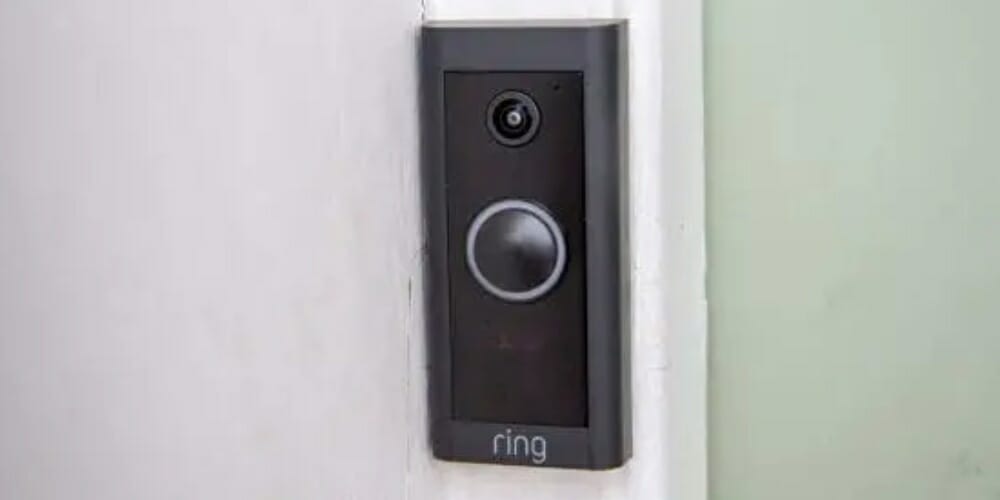Ring Video Doorbells combine the features of a smart doorbell and a smart peephole camera, and the result is even smarter than the sum of these parts. However, you can’t benefit from a Ring Doorbell if you have issues mounting it.
Installing a Ring doorbell is easy unless you have a very narrow frame. Here are some tips for installing a ring doorbell.
Using a corner kit is the easiest way to mount a Ring doorbell when your door frame is too narrow. Alternatively, you can buy a Ring Doorbell Pro, which is 38% thinner than the Ring Doorbell 2.
Summary of The Problems and Solutions
| Problem | Solution |
|---|---|
| Door is inset | 1. Use a corner kit to tilt the doorbell. 2. Use a wedge kit to tilt the camera vertically. |
| The door frame is narrow | 1. Use a corner kit to tilt the doorbell. 2. Use a thinner, hard-wire-only Ring Doorbell, and hardwire it. 3. Use a Ring Doorbell Pro, which is 38% thinner than Ring Doorbell 2. 4. Use a wedge kit to tilt the camera vertically. |
Note: Solutions 1 and 2 work for the door inset, and solutions 3, 4, and 5 work for narrow door frames.
Why a Ring Doorbell in a Narrow Doorframe is an Issue
The main purpose of Ring doorbells is to get a complete view of the door’s exterior. Ring Doorbells, allowing you to see who is outside. The creators of Ring Doorbells created a wide lens of 160 degrees for this purpose. However, installing a ring doorbell in a door frame can be an issue in certain scenarios.
Here, let us help you with some solutions when installing a ring doorbell in an awkward space becomes an issue.
Problem 1: The Door is Inset
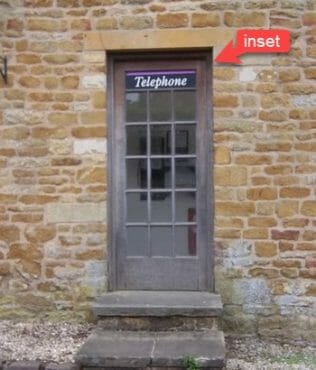
The first scenario in which installing a ring doorbell is an issue is when your door is inset. But what exactly do we mean by inset? The standard door is supposed to have some inches set in the wall. However, a door is considered an inset when its frame sits more than just a few inches in the wall.
An example would be the wall blocking half the lens of your Ring Doorbell and showing the wall instead of the visitors. We don’t want this, of course, since purchasing a ring doorbell is to record the visitors, not the wall.
A door inset can lead to further major problems, as a potential thief can use the hidden spots to approach your door. When half of the video lens is blocked by the door, the Ring doorbell can only capture a person when they’re standing right in front of the door. And that’s useless; from that moment, the ring footage will only display a person’s body instead of the face.
Problem 2: The Door Frame is Narrow
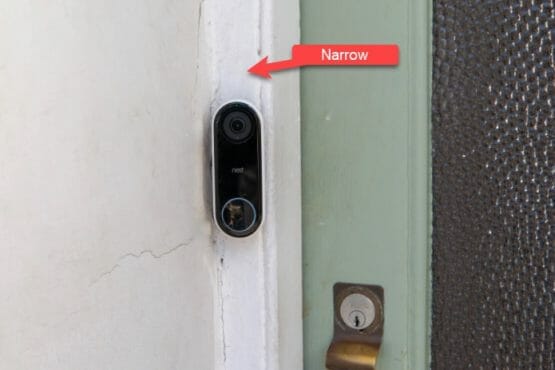
Another major Ring Doorbell mounting issue is when the door frame is too thin. This is another scenario where the wall blocks most of the footage the ring doorbell captures. The Ring Doorbell 1 is 6.35 cm or 2.5 inches wide. Normally, door frames are wider than 2.5 inches, but it can be an issue if it’s less than 2.5 inches.
If your ring doorbell is wider than your doorframe, you can’t afford to use a Ring Doorbell that uses a battery, as it would make the doorbell even bulkier than it is and will increase the width difference between the door frame and the Ring Doorbell further. Therefore, you will have to use a thinner, hard-wire-only Ring Doorbell, and you’ll have to hardwire it.
Solutions
Now that you know the problems of installing a doorbell on a narrow door with a protruding out the wall or a door placed a good distance behind it, it’s time to discuss the possible solutions.
But before reading, let us tell you that solutions 1 and 2 work for the door inset (mentioned in problem 1), and solutions 3, 4, 5, and 6, work for narrow door frames (mentioned in problem 2). Read away.
Solution 1: Tilt the Doorbell Using a Corner Kit
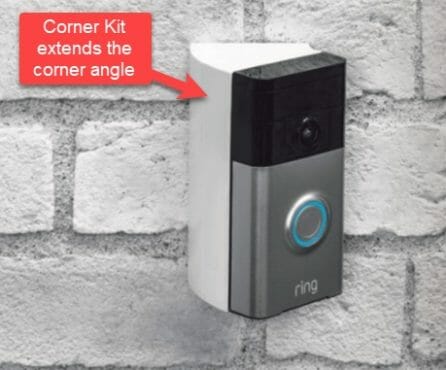
The first solution to problem one is using a corner kit. A corner kit is also called an angle mount. This innovative product changes the direction in which the doorbell points. Therefore, this changes the whole video-capturing field. Since the biggest issue in problem 1 was the wall blocking the ring doorbell field, using a corner kit solved the whole problem.
An example of this scenario will be a wall adjacent to your door blocking 40%-50% of the captured video. Using a corner kit, you can tilt your camera 30-50 degrees in the opposite direction to the wall to create a clear field where you can see the visitors instead of the wall. In our experience, this works perfectly well. Using a corner kit has effectively captured the field of view intended.
We also recommend using a corner kit for people who reside in the end house of a street. You can watch people walking in both directions on your street using these kits. Just determine the perfect angle, and you’re good to go!
Solution 2: Tilt the Camera Using a Wedge Kit
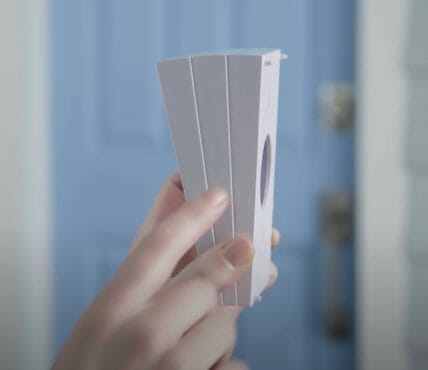
You might be surprised to hear that you should always install a ring doorbell 121 cm or 48 inches from the ground. As the average human height is around 163 cm or 64 inches, you might ask why installing a ring doorbell below doesn’t make much sense. However, ring doorbells have lenses that capture very wide angles. Therefore, Ring doorbells can even capture a person’s whole body from this height, including the face, even if they’re standing near the door. (1)
However, installing a doorbell this low has many other issues. If you install it that low, some external objects like door decorations or the door shade can block the view of your ring doorbell camera. You might also already have a ring doorbell installed high, and drilling holes at a different location can take a lot of effort. Either way, you must use a wedge kit to tilt your ring doorbell vertically. A wedge kit works much like a corner kit, but instead of tilting horizontally, a wedge ring tilts vertically. You can set what you want to see and what you don’t want to see by tilting your ring doorbell.
Using a wedge kit, your ring doorbell’s entire lens would focus on visitors instead of the street. You can tilt your ring doorbell 5-15 degrees, depending on the kind of wedge tilt kit you purchase.
Solution 3: Try the Ring Doorbell Pro
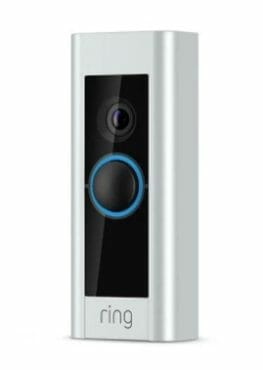
The width of the doorbell is the limiting factor here. The Ring Doorbell 1 is 2.4″ wide, whereas the Ring Doorbell 2 is 2.5” wide. In comparison, the Ring Doorbell Pro is 1.8” inches wide. This makes the Ring Doorbell 2 about 39% wider than the Ring Doorbell Pro.
If your only problem is the widths of the Ring Doorbell 1 and the Ring Doorbell 2, you should consider the Ring Doorbell Pro. The Ring Doorbell Pro also has a digital zoom feature, something the Ring Doorbell 1 or 2 don’t have.
The only caveat is that, unlike the Ring Doorbell 2, the Ring Doorbell Pro doesn’t have a battery option and has to be hardwired. If your door frame is thin, hardwiring the Ring Doorbell Pro may be difficult, but this is the perfect solution if you can.
Solution 4: Mount the Doorbell on the Wall
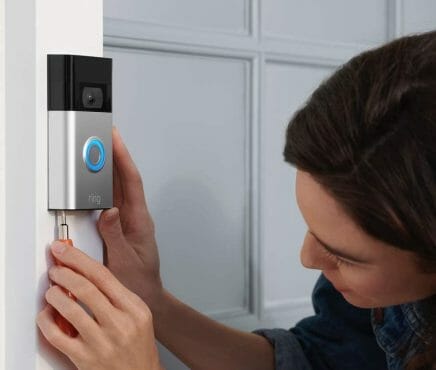
This solution applies to both problems discussed here. Instead of mounting the Ring Doorbell in the doorframe, mount it on the main wall next to the door. A wooden wall shouldn’t give you any trouble while wiring the Ring Doorbell.
But if the wall is concrete, you must run external wires. But you can cover the wires using a wire mold.
Alternatively, If you go with the Ring Doorbell 2 (or any later version), you can power the doorbell through a battery instead of a wire.
A downside is that if the wall is a good distance ahead of the door, the camera won’t offer much security since it won’t be able to cover the immediate front of the door. If someone chooses to knock on the door instead of ringing the bell, they may be standing too close to the door for the doorbell to see them. And the fact that the coverage angle of Ring doorbells is less than 180 degrees doesn’t help either.
Solution 5: Mount the Doorbell on the Door
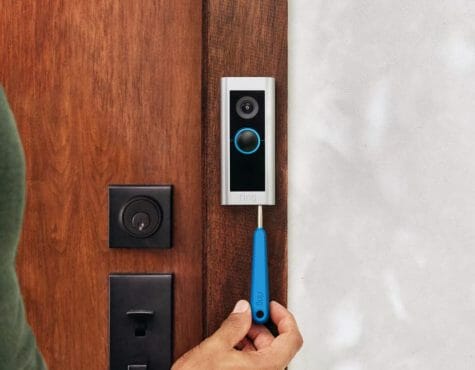
This solution solves the problems posed in the last paragraph. You can either hardwire a Ring Doorbell to the door or mount a battery-powered one. The latter seems easier to do, but it’s possible to hardwire a Ring Doorbell to the door as well.
Being mounted on the door, the camera can offer a much better view of the front than a door frame-mounted doorbell or a wall-mounted doorbell without using a wedge kit. But this method is quite unconventional, we must admit.
Solution 6: Use a Peephole Camera

Instead of using a Ring Doorbell, you could use a traditional doorbell and a peephole camera. But can a peephole camera replace the functionality of a video doorbell? We argue it can.
Peephole cameras have motion detection sensors. These cameras also allow you to define specific motion zones. You can define the front of the door as the motion zone, and the camera will send you a notification every time someone approaches your door.
Some peephole cameras even have AI-powered video analysis capabilities that allow the camera to tell people about pets and other motiving things. This means that you’ll only be notified when a person approaches the door and not when some other source of movement triggers the motion sensor. (2)
This may be even more secure than a video doorbell that doesn’t have motion detection or doesn’t cover the front of your door. A burglar with intentions to break in isn’t going to ring the bell first.
In our opinion, using a corner kit is the easiest and most effective of these solutions. A corner kit can also angle the Ring Doorbell if you mount it on the wall next to the door. However, if you don’t have any other options, you can always mount the Ring Doorbell on the door.
References
(1) average human height – https://ourworldindata.org/human-height
(2) AI-powered – https://techcrunch.com/2017/01/10/ai-powered-is-techs-meaningless-equivalent-of-all-natural/

